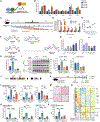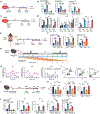Hepatocyte Period 1 dictates oxidative substrate selection independent of the core circadian clock
- PMID: 39412985
- PMCID: PMC11601098
- DOI: 10.1016/j.celrep.2024.114865
Hepatocyte Period 1 dictates oxidative substrate selection independent of the core circadian clock
Abstract
Organisms integrate circadian and metabolic signals to optimize substrate selection to survive starvation, yet precisely how this occurs is unclear. Here, we show that hepatocyte Period 1 (Per1) is selectively induced during fasting, and mice lacking hepatocyte Per1 fail to initiate autophagic flux, ketogenesis, and lipid accumulation. Transcriptomic analyses show failed induction of the fasting hepatokine Fgf21 in Per1-deficient mice, and single-nucleus multiome sequencing defines a putative responding hepatocyte subpopulation that fails to induce the chromatin accessibility near the Fgf21 locus. In vivo isotopic tracing and indirect calorimetry demonstrate that hepatocyte Per1-deficient mice fail to transit from oxidation of glucose to fat, which is completely reversible by exogenous FGF21 or by inhibiting pyruvate dehydrogenase. Strikingly, disturbing other core circadian genes does not perturb Per1 induction during fasting. We thus describe Per1 as an important mechanism by which hepatocytes integrate internal circadian rhythm and external nutrition signals to facilitate proper fuel utilization.
Keywords: CP: Metabolism; circadian clock; fasting; glucose oxidation; liver metabolism; metabolite tracing; single-nucleus multiome sequencing.
Copyright © 2024 The Author(s). Published by Elsevier Inc. All rights reserved.
Conflict of interest statement
Declaration of interests The authors declare no competing interests.
Figures






References
-
- Burgess SC, Jeffrey FMH, Storey C, Milde A, Hausler N, Merritt ME, Mulder H, Holm C, Sherry AD, and Malloy CR (2005). Effect of murine strain on metabolic pathways of glucose production after brief or prolonged fasting. Am. J. Physiol. Endocrinol. Metab 289, E53–E61. - PubMed
-
- Jones JG (2016). Hepatic glucose and lipid metabolism. Diabetologia 59, 1098–1103. - PubMed
Publication types
MeSH terms
Substances
Grants and funding
- T32 DK077653/DK/NIDDK NIH HHS/United States
- P30 DK056341/DK/NIDDK NIH HHS/United States
- R21 AT010520/AT/NCCIH NIH HHS/United States
- R01 HL147968/HL/NHLBI NIH HHS/United States
- P30 CA091842/CA/NCI NIH HHS/United States
- R01 DK131009/DK/NIDDK NIH HHS/United States
- P30 DK020579/DK/NIDDK NIH HHS/United States
- P30 DK052574/DK/NIDDK NIH HHS/United States
- R01 DK126622/DK/NIDDK NIH HHS/United States
- F31 DK131875/DK/NIDDK NIH HHS/United States
- UL1 TR002345/TR/NCATS NIH HHS/United States
- R56 DK115764/DK/NIDDK NIH HHS/United States
LinkOut - more resources
Full Text Sources
Molecular Biology Databases
Miscellaneous

